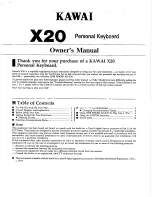
35
Overview of the Fantom-G
Over
view
Sound 1
Sound 2
Sound 3
Pad
Sampler
Menu/System
Appendix
Sequencer
Project
The largest unit of memory handled by the Fantom-G is the
“project.” As shown in the illustration, a project contains sequencer
data, samples, sounds, and various system settings. On the Fantom-
G you can use one project at a time.
Preset data
This is read-only data for patches, live sets, studio sets, rhythm sets,
and waves.
Internal memory
The Fantom-G has internal memory in which you can save a project.
A project can be overwritten at will. You can also restore the
memory to the factory-set condition (Factory Reset) (p. 284).
The internal memory is approximately 50 MB in size. If you need to
save a project that is larger than 50 MB, you’ll need to save it on USB
memory.
Temporary area
When you switch on the Fantom-G’s power or load a project, the
project data is placed in an area of memory called the “temporary
area.”
When you edit a patch or song, you are modifying the data in this
temporary area.
These edits will be lost if you simply turn off the power; if you want
to keep the changes you made, you must save them (SAVE/WRITE).
DIMM memory (sold separately)
You can install up to 1 GB of DIMM memory. Installing DIMM
memory will allow you to record or sample for a longer period of
time. For details on installing DIMM, refer to
USB memory (sold separately)
Internal memory can hold only one project, but commercially
available USB memory can hold multiple projects. Connect your
USB memory to the rear panel USB MEMORY connector (p. 24). For
details on how to format USB memory, refer to p. 284.
*
If the USB memory is formatted using something other than FAT, it
will not be recognized by the Fantom-G. Use your computer to format
the USB memory with the “FAT” or “FAT32” file system. (If you’re
using Mac OS X, format the USB memory using the “MS-DOS file
system (FAT32).”)
USB storage
You can use a USB cable to connect the Fantom-G to your hard disk,
and save (back up) projects from internal memory or USB memory
to the hard disk of your computer (p. 285).
Samples created using the Fantom-G can also be used by software on
your computer; or conversely, you can use your computer software
to create wave data and use it as samples in the Fantom-G.
Factory data
The factory data is memory that holds the factory-set state of the
internal memory. If you have deleted the factory-set patches or other
data from internal memory, and would like to use this data again,
you can execute the Factory Reset operation (p. 284).
*
If you’ve created important data and saved it in the Fantom-G’s
internal memory, be aware that your data will be lost if you execute a
Factory Reset. (
The data you’re in the process of editing will
also be lost
.)
Expansion boards
(ARX series; sold separately)
Up to two expansion boards (ARX series; sold separately) can be
installed in the Fantom-G. An expansion board includes a sound
generator engine, and will expand both the number of available
sounds and the polyphony. For details on installing expansion
boards, refer to
“Installing the Expansion Board”
About Memory
EXP 2
Fantom-G
Factory data
Internal memory (50 MB)
Factory reset
USB storage
Temporary area
Project
Project
USB memory
(sold separately)
Expansion boards
(sold separately)
Project
Computer
Sounds
Samples
System
Sequencer
Patches
USER: 512
EXP 1
Live sets
USER: 512
Studio sets
USER: 128
Rhythm sets
USER: 64
Sample sets
128
2000
samples
2000
phrases
50
songs
64
RPS sets
64
rhythm
pattern sets
Preset data
cannot be
overwritten
Patches
PRESET: 1668
GM: 256
Live sets
PRESET: 512
Studio sets
PRESET: 8
Rhythm sets
PRESET: 64
GM: 9
Waves
2230
(overwritable)
Load
Save
Load
Save
Select
Expandable to
1 GB with
DIMM memory
(sold separately)
( )
Fantom-G_r_e.book 35 ページ 2009年7月2日 木曜日 午後2時55分
















































